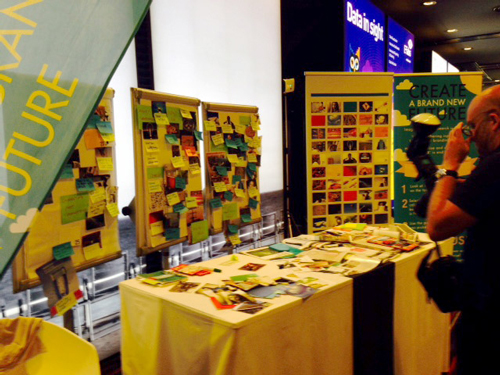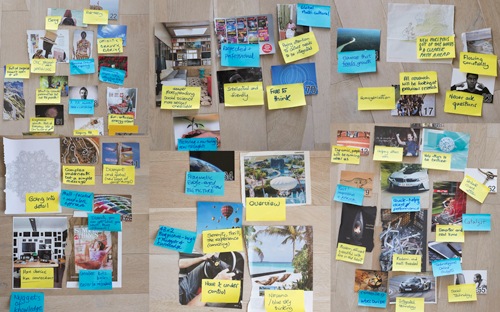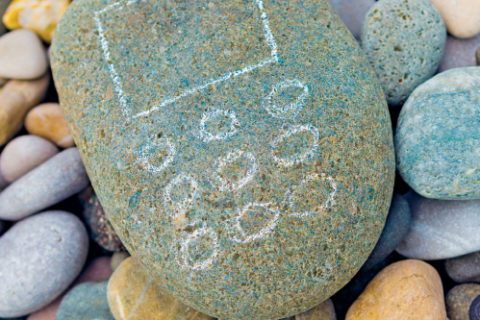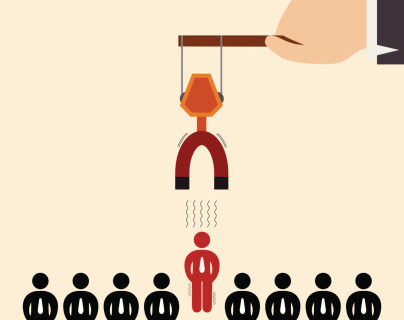Lucy Davison
Market researchers advise clients on their brands the whole time – it’s often our bread and butter. But where are the truly engaging brands; the Apples and Googles of market research? Having worked for many years in B2B branding I have seen what it has done for other industries and it has long struck me that branding is a great opportunity that is not being exploited by many MR companies. Branding could change perceptions of researchers as dull, grey and boring, it could attract new talent, engage audiences, demonstrate that we are a dynamic and exciting industry and enable us to behave with confidence. And B2B brands have become increasingly prominent; this year there were 20 in the BrandZ global table of top 100 brands – but no MR brands…
As this year’s Congress the theme was inspiration, so here at Mustard we decided it was a perfect opportunity to raise the issue of branding and also tap in to attendees’ imaginations. When we do branding projects, visualisation is one important element of our initial client workshop. We took this idea with us to Nice; we wanted people to visualise brand MR now, and brand MR in the future. The idea was to gather stimulus for a hypothetical ‘brand market research’ project.
ESOMAR gave us a table in the exhibition area, so we packed our suitcases and tucked some banners under our arms ready for our interactive two day session. We took bundles of magazines, lots of pens and post it notes, and tons of post cards with different images to use as stimuli. On the first day, we asked participants to pick up to three pictures that best described for them what market research is now. We asked them not to think too hard, to just ‘flick and pick’ (flick through the images and go for one/two or three that resonated with them). After they’d made their selection we then quizzed them on their choices and wrote the words they came up with on an accompanying post it. On day two, we asked them to pick images to best describe what they want Market Research to be in ten years’ time.
We thought we might be faced with a tough crowd; seasoned experts in this type of exercise. However we met only lively folk, who really engaged in what we were doing and clearly enjoyed it. We very quickly built up lots of vibrant imagery which we displayed on flip charts and themed and grouped together throughout the days. Of course, participants were able to respond to other people’s selections as well as make their own new ones – which added an interesting interactive dimension which increased as both days went on.
Our aim was to encourage participants to take a ‘system one’ approach; encouraging everyone to make quick decisions about what they were responding to, without thinking too much. After they had selected their images we then asked ‘why?’, and laddered up to find more rational meaning. Interestingly, we found that researchers with different areas of expertise reacted differently to our exercise. Semioticians, for example, tended to look in depth and analyse meaning within the images before choosing one. Quantitative researchers often agonised much more over making a quick decision or accessing their immediate emotional responses to imagery – sometimes they just couldn’t do it and just had to write some words instead!
Where is brand market research now?
We were a bit worried that we would get a lot of extremely diverse material which we could make no sense of, but we found that on both days our results fell into clear themes. We grouped these together and found out how people feel about research right now, which we wrote up as a little story:
We’re clear about our strengths in insight and deep human understanding but we realise we’re a bit old fashioned, boring, safe and lacking creativity. We tend to over-complicate and do too much. We are at crossroads and could go either way. Either we plunge downwards in fear, or climb upwards to find a path to a better future…either way we’re heading there fast.
And where is Market Research going?
On day two when we asked people to imagine market research in 10 years’ time, we were again able to tell a coherent story from the images and words. We put them together (as all the P’s);
We found that we want to build on our intellectual heritage with PhD level of cultural and social understanding, fostering creative ideas and thinking. But we’ll apply this practically. The path will be clear, flowing with continuous insight, and it will be predictive. We’ll have a panorama of choices, details, divergent ideas and knowledge. But we’ll be way more punk! And ultimately we’ll emerge in Nirvana with serenity and peace…
At the end of the two days we pulled the images and stories together into a little presentation which Dan Foreman shared with the Congress audience on the last day. To see it click here
What next? We’d love to explore more of hypothetical ‘brand MR’ to build the content we’d need for a strongly defined brand and a creative brief. But this visualisation exercise is only one small element of that – and of course Brand MR as a single entity does not really exist. It’s made up of thousands of companies of very different sizes and shapes…and of course trade associations like ESOMAR, MRS, ARF…So we’d like to ask you,what are your views on how to take this vision forwards?
On a final note, at Mustard, we always try to ‘future proof’ client brands, to set them in the context of what will be happening in five or ten years’ time. With this in mind, I wonder how many MR brands really do reflect the future ‘punk’ profile for the industry. None of the participants at ESOMOAR were talking about being reliable, honest, or delivering on time and budget. It was all about being imaginative, creative and ‘out there’. If your MR brand is not reflecting this or moving in this direction, you are in danger of becoming the ‘dad at the disco’ and getting left behind? Right now the whole industry looks a bit ‘dad’ like. But if it shows anything at all, it is that we are exciting, dynamic and imaginative types. Let’s show it!
Lucy Davison is Managing Director at Keen as Mustard Marketing
.





